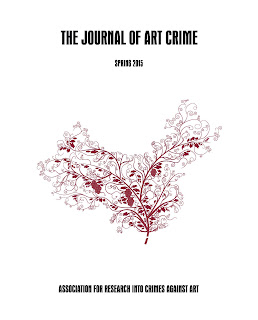Monday, August 12, 2019 -  Andrew Shannon,art theft,art thief,art vandalism,Dublin,Ireland,Rogues' Gallery
Andrew Shannon,art theft,art thief,art vandalism,Dublin,Ireland,Rogues' Gallery
 No comments
No comments
 Andrew Shannon,art theft,art thief,art vandalism,Dublin,Ireland,Rogues' Gallery
Andrew Shannon,art theft,art thief,art vandalism,Dublin,Ireland,Rogues' Gallery
 No comments
No comments
More from the Rogues' Gallery - An orphaned William Ashford painting, stolen in 2006, returns home.
Some art thieves are savvy characters, others are...let's just say, special.
By December 2018, burglar, petty criminal, art and book thief, Andrew Shannon has racked up 52 convictions for burglary, theft and criminal damages, 13 of which related to offenses which took place in foreign jurisdictions, including the handling of stolen property.
Some of his criminal offenses have been mundane, like the 2016 theft of seventeen electric toothbrushes worth only €200 from a supermarket in Swords, a suburb of Dublin. Others have been just plain peculiar, like the intentional damage he inflicted punching Monet's 1874 painting Argenteuil Basin with a Single Sail Boat, an incident that took place at the National Gallery of Ireland on 29 June 2012. That bizarre act of vandalism resulted in three tears, the longest of which was 25 centimeters, and took conservators eighteen months to repair. For this impulsive incident, Shannon was sentenced by Judge Martin Nolan in December 2014 to six year imprisonment, with the final 18 months of his sentence suspended.
 |
| Andrew Shannon Photo Credit: Collins |
A known serial thief as far back as 2009 Shannon seems to have had a penchant for burgling stately homes, often with the help of accomplices. Travelling from Ireland to target English properties, he often posed as a tourist, pilfering porcelain vases, ashtrays, books, ornamental lions, figurines, valuable antique books and once, even a walking stick.
 |
| Carton House in Kildare The historical family seat of the FitzGerald family. |
By 2014, police were narrowing in on his escapades and in April Ireland's Gardaí or "the Guards", the police service of the Republic executed a search warrant on Shannon's home and recovered some 43 paintings some immediately linked to known thefts and others not. While owners were identified for some of the artworks, others went unclaimed despite a nationwide appeal. Shannon sued for the return of these remaining art orphans, however, Judge John Coughlan ruled against him. Basing his ruling on the fact that Shannon was already notorious as a thief as well as the fact that the claimant had failed to provide verifiable proof of actual ownership, the judge ordered the forfeiture of all remaining unclaimed artworks which then become the property of the state.
In 2016 Shannon was convicted of stealing 57 stolen antique books, once part of the library at Carton House in Kildare, including one of only six rare 1660 editions of the King James Bible. The books had disappeared in November 2006 when left in storage during a restoration of the country house. These were recovered in the suspect's home, displayed in neat rows. When questioned about their origins, Shannon lied to the authorities and stated that he had purchased them in 2002 at a fete in the Midlands.
In 2016 Shannon was convicted of stealing 57 stolen antique books, once part of the library at Carton House in Kildare, including one of only six rare 1660 editions of the King James Bible. The books had disappeared in November 2006 when left in storage during a restoration of the country house. These were recovered in the suspect's home, displayed in neat rows. When questioned about their origins, Shannon lied to the authorities and stated that he had purchased them in 2002 at a fete in the Midlands.
As recently as May 2019 Shannon lost his appeal Dublin Circuit Criminal Court over an earlier conviction stemming from the theft of an 1892 oil painting by Frederick Goodall stolen from Bantry House, in Cork, in March of 2006. Blaming his sticky fingers on both his heart disease and his addiction to benzodiazepines and harder substances while recovering from a quadruple heart bypass, the court prosecution built their case against the prolific offender by illustrating how the kleptomaniac had habitually and repeatedly filched a surprising array of objects, some of which had very little monetary value. Not buying into offender's medical complications excuse, Judge Patricia Ryan sentenced Shannon to two years imprisonment, backdating Shannon's sentence to 20 February 2018, the day he was taken into custody for this particular offense.
Flash forward to this summer, when in June 2019 one of the seized 2014 artworks, a painting by English painter William Ashford, was put up for sale at Adams Art Gallery. As a result of the publicity around the upcoming sale, the painting was recognized by someone who had once worked on the artwork when it was part of the collection at the Royal Dublin Society.
This orphaned artwork, missing since 2006, has now been returned to the RDS.















